Art and war seem poles apart. War is violent, murderous, ugly, an orgy of blood and death, humanity gone mad. Art is lofty, spiritual, beautiful, a rapturous celebration of life and the human spirit.
Japan’s earliest arts were arts of peace. Japan was a nation of peace, at peace. Its civilization was born in peace, circa 500 A.D., and nurtured in peace for 700 years thereafter. Its loveliest artifacts are Buddhist statues of the eighth, ninth and 10th centuries — wood, clay and bronze figures, bodhisattvas for the most part, their faces and poses reflecting a serenity that seems scarcely of this world and yet there is nothing remote about it. Its sublimity pierces the heart — even the modern heart, keyed to turmoil. What if war had never broken out? Maybe we’d all be bodhisattvas now.
Idle fancy. Was war inevitable? It came, inevitably or not, and from the late 12th century to the early 17th, Japan was almost perpetually at war. It was civil war mostly. Apart from two Mongol invasions — both repelled, the first in 1274 and the second seven years later — the outside world paid Japan little heed, leaving its warriors free to slaughter each other, which they did with unwearying gusto for the better part of half a millennium. How art of any kind could have survived and even flourished in the seemingly endless carnage is one of the enduring mysteries. Other civilizations — ancient Greek, medieval European — had their Dark Ages, near-total eclipses of everything that makes life gracious. Japan’s darkest age was an age of light.


















With your current subscription plan you can comment on stories. However, before writing your first comment, please create a display name in the Profile section of your subscriber account page.